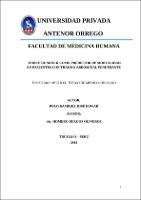Índice de shock como predictor de mortalidad en pacientes con trauma abdominal penetrante

Ver/
Descargar
(application/pdf: 478.2Kb)
(application/pdf: 478.2Kb)
Fecha
2014Autor(es)
Polo Ramirez, José Edwar
Metadatos
Mostrar el registro completo del ítemResumen
Determinar si el Índice de shock a la admisión es un predictor de mortalidad en pacientes con trauma abdominal penetrante en el Hospital Regional Docente de Trujillo.
MATERIAL Y MÉTODO: Se realizó un estudio observacional, analítico, de casos y controles anidados, que evaluó 144 pacientes, los cuales fueron distribuidos en dos grupos: Grupo I: 16 pacientes que fallecieron y Grupo II: 128 pacientes que sobrevivieron.
RESULTADOS: La edad promedio para el grupo I fue 27,44 ± 6,49 años y para el grupo II fue 24,93 ± 5,51 años; el 87,5% de los pacientes correspondieron al sexo masculino en el grupo I y en el grupo II 98,44%; el tipo de arma utilizada más frecuente fue el proyectil por arma de fuego en 100% y 92,19% en el grupo I y II respectivamente. En lo que respecta al índice de shock categorizado a un punto de corte de 0,7, el 100% de los fallecidos tuvo un valor por encima de > 0,7 y en el grupo de pacientes que sobrevivieron el 74,23% de los pacientes tuvo un valor por encima de este punto de corte (p < 0,05); la sensibilidad, especificidad, VPP y VPN fueron 100%, 25,78%, 14,41% y 100% respectivamente; siendo el rendimiento diagnóstico global del índice de shock en predecir mortalidad del 89,01%.
CONCLUSIONES: El índice de shock mostró un rendimiento diagnostico en predecir mortalidad en pacientes con trauma abdominal penetrante del 90%. To determine whether the shock index admission is a
predictor of mortality in patients with penetrating abdominal trauma in
Trujillo Regional Teaching Hospital.
MATERIAL AND METHODS: We conducted an observational,
analytical, nested case-controls study that evaluated 144 patients, which
were divided into two groups: Group I: 16 patients who died and Group II:
128 patients who survived.
RESULTS: The mean age of group I was 27.44 ± 6.49 years and for group
II was 24.93 ± 5.51 years; the 87.5% of patients were male in the group I
and group II 98.44%; the type of weapon used was the most common
firearm projectile at 100% and 92.19% in group I and II respectively. With
respect to the shock index categorized to a cutoff of 0.7, 100% of those who
died had a higher value of > 0.7 and in the group of patients who survived
the 74.23% of the patients had a value above this cutoff (p < 0.05); the
sensitivity, specificity, PPV and NPV were 100%, 25.78%, 14.41% and
100% respectively; with an overall diagnostic yield of shock index in
predicting mortality of 89.01%..
CONCLUSIONS: The index showed shock performance diagnosis predicts
mortality in patients with penetrating abdominal trauma 90%
Palabras clave
Colecciones
- Medicina Humana [2969]

